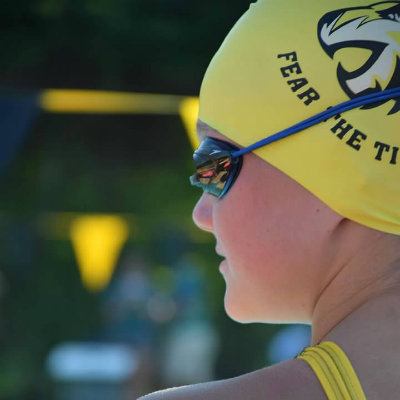
Nina's Story

Eighteen-year-old Nina Nichols can clearly picture her future, and it involves being under the watchful eye of clinicians at Children’s National Hospital as the high school senior eats two peanut M&Ms: sleek candy shell on the outside, chocolate on the inside and at its core, a crunchy peanut. Nina’s goal is to chew away without drama, and certainly without the wheezing and throat swelling that accompanies life-threatening anaphylaxis.
Even though they are largely distant memories, Nina and her family all too well know the anxiety they experienced early in her life when she ate food containing peanuts by accident. As a toddler, a friend innocently gave her a peanut butter cracker because Nina wanted a snack. Her lips swelled, her body became covered with hives and, as her parents sped her to the hospital, she began vomiting. It took two injections of epinephrine in the Emergency Department that day to stop her anaphylactic reaction.
Nina experienced her second anaphylaxis two years later as a preschooler when she ate a cookie at school that the school and the parent who brought them said contained no peanuts.
“We had notified the teachers; my mom even contacted the parent separately. They got pictures of the label. We thought we were good,” Nina says. “It turns out, there were peanut traces in the cookies.” That time, she stayed in the hospital overnight.
Her mom trained her how to tell waiters or waitresses about her life-threatening peanut allergy, so the staff could alert the chef to avoid peanuts touching her plate or her food.
“They would look at me as if I was crazy. My family would have to say: ‘If she eats a peanut, she could die.’ We often ended up putting our trust in them, even though it was sometimes clear they didn’t even know what a peanut allergy was,” she recalls.
And at school, it troubled her to not eat the same things as school friends.
“I didn’t get to eat the pink fluffy cupcakes with the sprinkles one Valentine’s Day. I had brought my own brown cupcake from home,” she recalls. “My grandma would always make me a chocolate cupcake. I realize now that my grandma’s cupcakes were a lot better than those store-bought cupcakes. Back then, I just wanted to be like everyone else.”
As time passed, food allergy awareness grew, going to a restaurant got easier, as did traveling.
“As I got older, I realized not eating the same food as everyone was a choice between that food and my own safety,” she adds. “I’m so thankful for my family - especially my mom. Peanut allergy was a burden for me when I was younger. Now, it’s just another thing about me that makes me more interesting. As the world has gotten more experience with food allergies, it has become less of a burden.”
Then her mom Maria Acebal, the former CEO of the Food Allergy & Anaphylaxis Network, learned about a clinical trial for an oral immunotherapy for peanut allergy that aimed to calm the trial participants’ immune systems so they wouldn’t go into hyperdrive after peanut exposure. Acebal found trial sites in New York and Baltimore, but the travel was daunting. She emailed Hemant Sharma, M.D., M.H.S., at Children’s National, to see if he knew about a trial that was closer.
As luck had it, Children’s National was one of the sites recruiting patients.
A couple weeks later, Nina was seen at the clinic and ate one-half milligram (mg) of peanut protein, then 1 mg, then 3 mg, then 6 mg. She reacted to 6 mg, which is the equivalent of 1/50 of a peanut and developed wheezing and a facial rash that was treated with an epinephrine auto-injector. She qualified for the clinical trial, and every two weeks they increased the dosage of the peanut powder, going from 3 mg at the beginning and rising to 300 mg - the equivalent of one peanut - by December 2018. She’s been eating a controlled dosage of 300 mg since that time, disguising the taste by mixing the powder into ice cream or a smoothie.
“The best I can describe is it tastes like cardboard,” Nina says. “It’s not fun eating, but my little skin test allergy prick before used to be a ginormous bump on my wrist or back. Now, it’s a lot smaller.”
When she has reactions now, which occur rarely, there is much less drama - apart from May 2018. That day, she changed the timing of her dose, taking it a little earlier in the day. Then she walked a few leisurely blocks to pick up her little brother at school and ended up needing an ambulance transport and two doses of epinephrine administered at the school.

Clinical trial participants are not allowed to shower with hot water after a dose, because it could trigger a reaction, as can exercising after a dose.
Despite those minor downsides, Nina was so impressed with how the experimental immunotherapy has changed her life that she testified during a mid-September 2019 public hearing in favor of the Food and Drug Administration approving it.
“Peanuts are not on my mind as much. I wouldn’t say I was ever in constant worry. I always had it in the back of my head to not go into restaurants that had peanuts on the floor. Even people you kiss, you have to make sure they haven’t eaten peanuts in a long time.”
For the first time, she can eat Nestlé Toll House cookie dough (by the tub). In fact, she now can eat any item that has a “may contain” peanut products warning, the same type of food that triggered an overnight hospital stay a dozen years ago when she was a preschooler.
“As I get older, I don’t want my peanut allergy to stop me,” says Nina, a competitive swimmer.
So, she and her mom have been taking outings, scouting out campuses where she might attend college to study medicine. Nina took a school trip to India, traveling to New Delhi and Dharamshala, bringing back big red passport stamps that cover half the page, while remaining adherent to the clinical trial protocol.
In December 2019, she plans to participate in a food challenge under clinical team guidance, upping her dose of peanut powder from 300 mg, to 600 mg, 1,000 mg and then to 2,000 mg.
If she makes it to 1,000 mg without suffering a severe reaction, she advances to the next stage: A spoonful of peanut butter. Six Reese’s Pieces. Or two peanut kernels. Or two peanut M&Ms.
“There is no family more ready for this trial,” she says.



